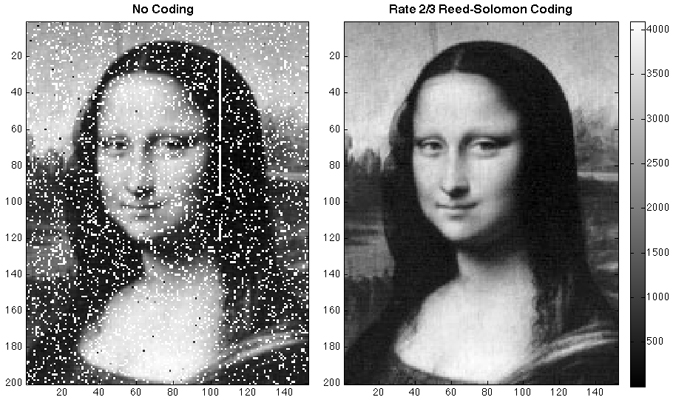|
01.17.13 As part of the first demonstration of laser communication with a satellite at the moon, scientists with NASA's Lunar Reconnaissance Orbiter (LRO) beamed an image of the Mona Lisa to the spacecraft from Earth. The iconic image traveled nearly 240,000 miles in digital form from the Next Generation Satellite Laser Ranging (NGSLR) station at NASA's Goddard Space Flight Center in Greenbelt, Md., to the Lunar Orbiter Laser Altimeter (LOLA) instrument on the spacecraft. By transmitting the image piggyback on laser pulses that are routinely sent to track LOLA's position, the team achieved simultaneous laser communication and tracking. NASA Goddard scientists transmitted an image of the Mona Lisa from Earth to the Lunar Reconnaissance Orbiter at the moon by piggybacking on laser pulses that routinely track the spacecraft. Credit: NASA's Goddard Space Flight Center › Download video in HD formats "This is the first time anyone has achieved one-way laser communication at planetary distances," says LOLA's principal investigator, David Smith of the Massachusetts Institute of Technology. "In the near future, this type of simple laser communication might serve as a backup for the radio communication that satellites use. In the more distant future, it may allow communication at higher data rates than present radio links can provide." Typically, satellites that go beyond Earth orbit use radio waves for tracking and communication. LRO is the only satellite in orbit around a body other than Earth to be tracked by laser as well. "Because LRO is already set up to receive laser signals through the LOLA instrument, we had a unique opportunity to demonstrate one-way laser communication with a distant satellite," says Xiaoli Sun, a LOLA scientist at NASA Goddard and lead author of the Optics Express paper, posted online today, that describes the work. Precise timing was the key to transmitting the image. Sun and colleagues divided the Mona Lisa image into an array of 152 pixels by 200 pixels. Every pixel was converted into a shade of gray, represented by a number between zero and 4,095. Each pixel was transmitted by a laser pulse, with the pulse being fired in one of 4,096 possible time slots during a brief time window allotted for laser tracking. The complete image was transmitted at a data rate of about 300 bits per second. The laser pulses were received by LRO's LOLA instrument, which reconstructed the image based on the arrival times of the laser pulses from Earth. This was accomplished without interfering with LOLA's primary task of mapping the moon's elevation and terrain and NGSLR's primary task of tracking LRO. The success of the laser transmission was verified by returning the image to Earth using the spacecraft's radio telemetry system. Turbulence in Earth's atmosphere introduced transmission errors even when the sky was clear. To overcome these effects, Sun and colleagues employed Reed-Solomon coding, which is the same type of error-correction code commonly used in CDs and DVDs. The experiments also provided statistics on the signal fluctuations due to Earth's atmosphere. To clean up transmission errors introduced by Earth's atmosphere (left), Goddard scientists applied Reed-Solomon error correction (right), which is commonly used in CDs and DVDs. Typical errors include missing pixels (white) and false signals (black). The white stripe indicates a brief period when transmission was paused. Image courtesy: Xiaoli Sun, NASA Goddard › Larger image "This pathfinding achievement sets the stage for the Lunar Laser Communications Demonstration (LLCD), a high data rate laser-communication demonstrations that will be a central feature of NASA's next moon mission, the Lunar Atmosphere and Dust Environment Explorer (LADEE)," says Goddard's Richard Vondrak, the LRO deputy project scientist. The next step after LLCD is the Laser Communications Relay Demonstration (LCRD), NASA's first long-duration optical communications mission. LCRD will help develop concepts and deliver technologies applicable to near-Earth and deep-space communication. Laser light made records obsolete. NASA is on the verge of doing the same thing with space based communications. Before the end of the decade, the Laser Communication Relay Demonstration (LCRD) mission will revolutionize the way we move tons of data from orbit to ground and all around the solar system. Credit: NASA's Goddard Space Flight Center › Download video in HD formats NASA Goddard developed and manages the LRO mission and the LOLA instrument. The LRO mission is funded by NASA's Planetary Science Division in the Science Mission Directorate at NASA Headquarters in Washington. NGSLR is funded by the Earth Science Division at NASA Headquarters. LLCD is funded through a partnership with NASA's Space Communications and Navigation (SCaN) Program, and Science Mission Directorate. LCRD is funded through a partnership with SCaN and NASA's Office of the Chief Technologist. Text issued as NASA Goddard release No. 13-003 Nancy Neal-Jones / Elizabeth Zubritsky NASA's Goddard Space Flight Center, Greenbelt, Md. 301-286-0039 / 301-614-5438 [email protected] / [email protected] http://www.nasa.gov/mission_pages/LRO/news/mona-lisa.html
Comments are closed.
|
Archives
March 2021
|

 RSS Feed
RSS Feed